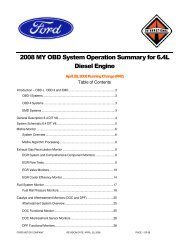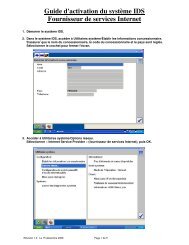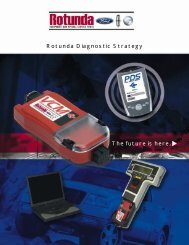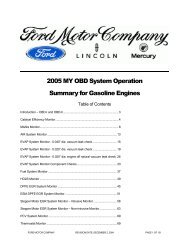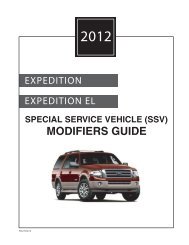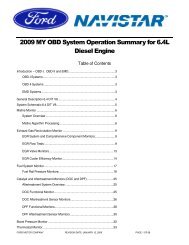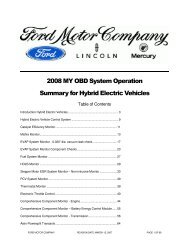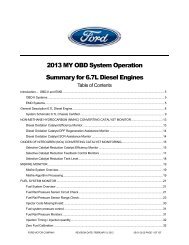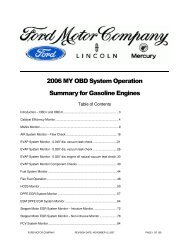2005 MY OBD System Operation Summary for Gasoline Engines
2005 MY OBD System Operation Summary for Gasoline Engines
2005 MY OBD System Operation Summary for Gasoline Engines
You also want an ePaper? Increase the reach of your titles
YUMPU automatically turns print PDFs into web optimized ePapers that Google loves.
The evap system integrity test is done in four phases.%1# 6" )7First, the Canister Vent Solenoid is closed to seal the entire evap system, then the VMV or EVMV is opened topull a 8" H 2 O vacuum. If the initial vacuum could not be achieved, a large system leak is indicated (P0455). Thiscould be caused by a fuel cap that was not installed properly, a large hole, an overfilled fuel tank,disconnected/kinked vapor lines, a Canister Vent Solenoid that is stuck open, a VMV that is stuck closed, or adisconnected/blocked vapor line between the VMV and the FTPTIf the initial vacuum could not be achieved after a refueling event, a gross leak, fuel cap off (P0457) is indicatedand the recorded minimum fuel tank pressure during pulldown is stored in KAM. A “Check Fuel Cap” light mayalso be illuminated.If the initial vacuum is excessive, a vacuum malfunction is indicated (P1450). This could be caused by kinkedvapor lines or a stuck open VMV. If a P0455, P0457, or P1450 code is generated, the evap test does notcontinue with subsequent phases of the small leak check, phases 1-4.Note: Not all vehicles will have the P0457 test or the Check Fuel Cap light implemented. These vehicles willcontinue to generate only a P0455. After the customer properly secures the fuel cap, the P0457, Check Fuel Capand/or MIL will be cleared as soon as normal purging vacuum exceeds the P0457 vacuum level stored in KAM.1#& 2+8If the target vacuum is achieved, the VMV is closed and vacuum is allowed to stabilize <strong>for</strong> a fixed time. If thepressure in the tank immediately rises, the stabilization time us bypassed and Phase 2 of the test is entered.Some software has incorporated a "leaking" VMV test, which will also set a P1450 (excessive vacuum) DTC. Thistest is intended to identify a VMV that does not seal properly, but is not fully stuck open. If more than 1 " H 2 O ofadditional vacuum is developed in Phase 1, the evap monitor will bypass Phase 2 and go directly to Phase 3 andopen the canister vent solenoid to release the vacuum. Then, it will proceed to Phase 4, close the canister ventsolenoid and measure the vacuum that develops. If the vacuum exceeds approximately 4 " H 2 O, a P1450 DTCwill be set.1# 2#Next, the vacuum is held <strong>for</strong> a calibrated time and the vacuum level is again recorded at the end of this timeperiod. The starting and ending vacuum levels are checked to determine if the change in vacuum exceeds thevacuum bleed up criteria. Fuel Level Input and ambient air temperature are used to adjust the vacuum bleed-upcriteria <strong>for</strong> the appropriate fuel tank vapor volume. Steady state conditions must be maintained throughout thisbleed up portion of the test. The monitor will abort if there is an excessive change in load, fuel tank pressure orfuel level input since these are all indicators of impending or actual fuel slosh. If the monitor aborts, it will attemptto run again (up to 20 or more times). If the vacuum bleed-up criteria is not exceeded, the small leak test isconsidered a pass. If the vacuum bleed-up criteria is exceeded on three successive monitoring events, a 0.040 “dia. leak is likely and a final vapor generation check is done to verify the leak, phases 3-4. Excessive vaporgeneration can cause a false MIL.1#9 2The vapor generation check is done by releasing any vacuum, then closing the VMV, waiting <strong>for</strong> a period of time,and determining if tank pressure remains low or if it is rising due to excessive vapor generation1#4 2If the pressure rise due to vapor generation is below the threshold limit <strong>for</strong> absolute pressure and change inpressure, a P0442 DTC is stored.FORD MOTOR COMPANY REVISION DATE: APRIL 28, 2004 PAGE 17 OF 131



